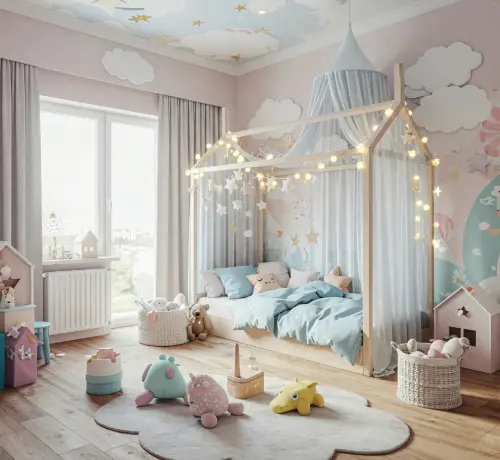Introduction:
Step into a world where imagination reigns supreme, where bedtime stories come to life, and where every corner holds the promise of adventure. Designing a child's fantasy room is more than just picking out paint colors and furniture; it's about creating a personalized sanctuary that nurtures their creativity, fosters their dreams, and makes them feel truly special. Get ready to sprinkle some magic and embark on a journey to craft a space where little dreamers can thrive!
1. Unleash the Theme: Where Will Their Imagination Take Them?
The first step in creating a fantasy room is to tap into your child's passions and interests. What worlds ignite their imagination?
- Enchanted Forest: Think whimsical woodland creatures, soft greens and browns, fairy lights twinkling like fireflies, and maybe even a cozy reading nook resembling a tree hollow.
- Galactic Explorer: Blast off with deep blues and purples, glow-in-the-dark stars and planets, a rocket ship bed, and storage that looks like lunar modules.
- Under the Sea Adventure: Dive into an ocean of blues and teals, with playful sea creatures adorning the walls, a ship-shaped bed, and flowing fabrics mimicking seaweed.
- Superhero Headquarters: Empower your little hero with bold colors, cityscape silhouettes, their favorite superhero emblems, and perhaps a climbing wall for training missions.
- Royal Kingdom: Create a majestic space with soft pastels, elegant furniture, a canopy bed fit for a prince or princess, and shimmering accents.
Don't be afraid to get creative and let your child's unique vision guide the theme!
2. The Magic of Color and Light: Setting the Atmosphere
Color and light play a crucial role in creating the desired ambiance:
- Color Psychology: Consider how different colors evoke different feelings. Soft blues and greens can be calming for sleep, while brighter hues like yellows and oranges can stimulate creativity during playtime.
- Accent Walls: A single themed accent wall can make a big impact without overwhelming the space. Consider murals, patterned wallpaper, or even textured paint.
- Layered Lighting: Incorporate a mix of ambient lighting (overhead), task lighting (reading lamps), and accent lighting (fairy lights, nightlights) to create depth and flexibility. Dimmable lights can help transition from playtime to bedtime.
- Natural Light: Maximize natural light with sheer curtains or blinds that allow sunlight to filter in, making the room feel airy and inviting.
3. Furniture with Flair: Functional and Fantastical
Choose furniture that not only serves its purpose but also enhances the theme:
- Themed Beds: A race car bed, a princess carriage bed, or a loft bed designed like a pirate ship can be the centerpiece of the room.
- Creative Storage: Think treasure chests for toys, bookshelves shaped like castles, or wall-mounted organizers resembling clouds.
- Multifunctional Pieces: Ottomans with hidden storage, desks that can transform into art stations, or seating that doubles as play structures maximize space and functionality.
- Comfort and Safety: Ensure all furniture is child-safe with rounded edges and non-toxic finishes. Comfortable rugs and cushions will make the space inviting for play and relaxation.
4. Enchanting Decor and Details: Bringing the Theme to Life
This is where you can truly let your creativity shine:
- Wall Decor: Murals, decals, posters, framed artwork, and even fabric banners can reinforce the chosen theme.
- Textiles: Themed bedding, curtains, rugs, and throw pillows add layers of texture and visual interest.
- Personalized Touches: Incorporate your child's own artwork, creations, and favorite toys to make the space truly their own.
- Interactive Elements: Consider adding a chalkboard wall for drawing, a canopy for imaginative play, or a designated reading nook with cozy cushions.
- Sensory Experiences: Think about incorporating elements that engage different senses, such as soft textures, calming sounds (like a white noise machine), or even subtle scents (like lavender for relaxation).
5. Growing with Your Little Dreamer: Designing for Longevity
While creating a fantastical space is exciting, consider how the room can adapt as your child grows:
- Versatile Themes: Choose themes with elements that can be easily updated or modified.
- Adaptable Furniture: Opt for furniture that can serve multiple purposes or be reconfigured as needed.
- Neutral Base: Use a neutral color palette for the walls and larger furniture pieces, and introduce the theme through decor and accessories that can be easily changed.
- Involve Your Child: As they get older, involve them in the design process to ensure the room continues to reflect their evolving interests.
Conclusion:
Designing a kids' fantasy room is a wonderful opportunity to tap into your own creativity and create a truly magical space for your little one. By understanding their dreams, choosing a captivating theme, and incorporating thoughtful details, you can craft a room that not only looks enchanting but also nurtures their imagination, encourages their growth, and provides a cherished haven for years to come. So, let the adventure begin, and watch as your little dreamer's eyes light up with wonder in their very own fantasy world!


